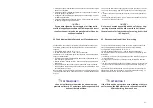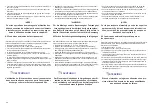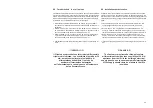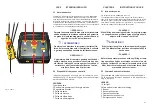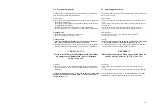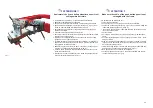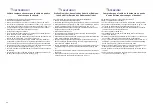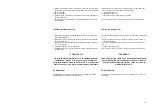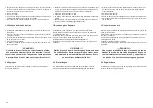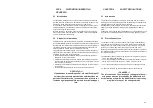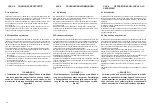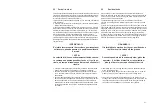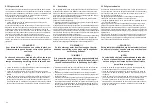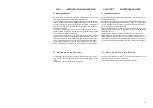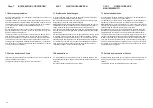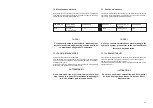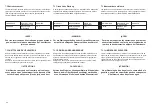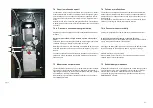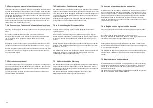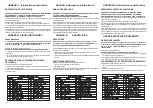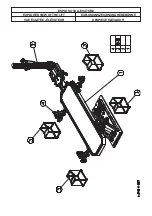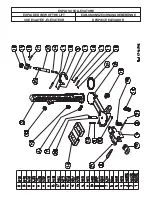
6.3
Pericoli residui
La lettura approfondita di tale paragrafo è necessaria poiché consente all’uti-
lizzatore o/e all’operatore di conoscere i pericoli derivanti dall’utilizzo del sol-
levatore e permette quindi, unitamente alla lettura dell’intero manuale, di po-
ter consapevolmente e correttamente operare.
I pericoli residui rilevati nelle varie attività in cui è coinvolto il sollevatore
sono i seguenti:
·
rischio di schiacciamento, o cesoiamento, connesso alla discesa del
telaio mobile del sollevatore:
a) Sono previste due staffe di sicurezza che, in assenza, di carico, bloccano
la discesa del telaio a 120 mm da terra; tali staffe devono essere disarmate
manualmente dall’utilizzatore in caso di discesa finale; per i rimanenti 120
mm l’utilizzatore deve porre la massima attenzione a non sostare con gli arti
inferiori sotto il telaio, in quanto permane pericolo di schiacciamento;
b) in presenza dell’autovettura, in fase di discesa; esiste il rischio di schiac-
ciamento degli arti inferiori per mezzo delle ruote della stessa (se presenti).
Questo pericolo è ovviato dalla visibi ità completa dell’utilizzatore riguardo il
campo di lavoro;
!!! PERICOLO !!!
E’ vietato lavorare sotto l’autovettura, posizionata sul
sollevatore, quando questa è in posizione sollevata
da terra.
! NOTA !
La velocità di discesa, estremamente ridotta, consen-
te comunque a qualunque addetto che si trovi in pe-
ricolo, un tempo di reazione sufficiente ad eliminare il
rischio.
·
rischio di caduta del carico (autovettura) qualora in fase dì discesa
siano presenti ostacoli che agiscono con azione di contrasto;
·
rischio di proiezione di oggetti nella parte posteriore dei braccio di
tiro, o nelle immediate vicinanze, dovuti a rotture durante l’utilizzo
della catena;
·
rischio di tranciamento del cavo elettrico di alimentazione della cen-
tralina e dei tubi di collegamento (oleodinamici e pneumatici) tra cen-
tralina e sollevatore; in caso di tranciamento dei tubi dell’impianto
oleodinamico il mantenimento della posizione del sollevatore è assi-
curato da due valvole di non ritorno, installate sull’ingresso dell’olio
nei cilindri.
6.3
Residual risks
It is necessary to read this paragraph with particular attention as it
brings the attention of the user and/or operator to the dangers deriving
from use of the lift and, also by reading the whole manual, he/she can
work correctly and with awareness
.
The residual dangers found in the various activities of the lift are
crushing or shearing hazard, related to the descent of the lift’s mobile
frame:
a) there are two safety brackets which, when there is no load, locks de-
scent of the frame 120 mm from the ground; these brackets must be di-
sengaged manually by the user in the case of complete descent; for the
remaining 120 mm the user must pay maximum attention NOT to stand
with his/her legs under the frame as there is the danger of crushing.
b) when a car is on the lift and when it is descending there is the risk of
legs being crushed by the wheels (if mounted). This danger is avoided
because the user has an all round view of the working field
;
!!! DANGER !!!
It is forbidden to work under the car, positioned on
the lift when it is raised off the ground
.
! NOTE !
Descent speed, which is extremely slow, gives the
operator – if he finds himself in a risky situation –
plenty of time to react and eliminate the risk
.
·
load falling risk (car) if, during descent, there are obstacles that act
with a contrasting action;
·
risk of objects being flung at the rear of the pulling arm, or in the im-
mediate vicinity, due to breaks when the chain is being used;
·
risk of the unit’s electrical power lead being cut as well as the con-
necting pipes (hydraulic and pneumatic) between the unit and the lift;
if the hydraulic pipes are cut the position of the lift is guaranteed by
two check valves installed on the oil input in the cylinders
.
41

